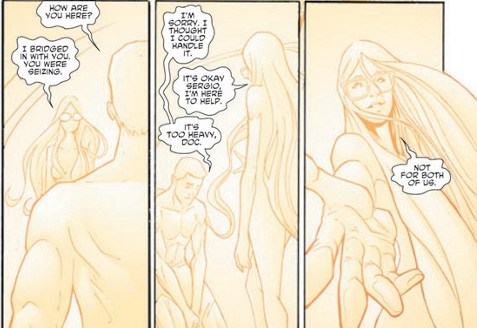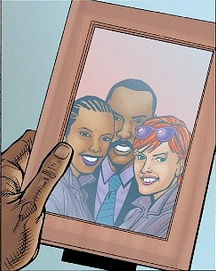The first trailer I saw for Pacific Rim had me hooked. Amazing director? Check. Geek/pop-culture cast? Check. Giant mechs fighting giant monster aliens? Check check check! So when I discovered there was a graphic novel accompaniment to the spectacular, of course it went straight on my list. Even better, this is no loose tie-in comic but comes from the writer of the film Travis Beacham, with direct supervision from Guillermo del Toro himself, and is released by Legendary and Warner Bros, the team that brought us the Nolan Batman trilogy, Inception and Watchmen films. The cover by Adam Ross looks like an image from a D&D manual, and the inside artwork is smooth, expressive and compliments the speech as well as the film does.
Pacific Rim might not be the deepest, smartest or most original story, but that’s okay. It has elements of Lovecraftian mythology, inspiration from old school Kaiju films like Godzilla, and exoskeleton anime themes from Neon Genesis Evangelion; it’s basically one big love letter to sci-fi, fantasy and monster flicks, produced on an epic scale. Like any good sci-fi and fantasy story, the plot takes place within a huge world which sprawls off the edge of what we see – whether it’s understanding the political history of the families in Game of Thrones, the slang used in Battlestar Galactica or the political and economic status of a world ravaged by monsters. It’s something del Toro is great at discussing, knowing as he does that no story stands alone. The graphic novel Tales From Year Zero takes place over ten years, from the first Kaiju attack to a time just before the film’s story begins and gives us a little more insight into the characters, and how the Jaeger programme was formed.
A reporter in 2024 is writing a fluff piece entitled “Why we fight..” about the Kaiju war. Wanting to talk to Stacker Pentecost, journalist Naomi instead ends up talking to Tendo Choi, the J-tech chief behind the desk played by Clifton Craig Collins Jr, who was there on K-Day. The great thing about this was seeing that attack again – that one from the trailer where the Kaiju Trespasser crashes through the Golden Gate Bridge in San Francisco. It’s huge, and awesome – the rich colours on the page coupled with the truly cinematic tremors and onomatopoeic “noises” evoke that same colossal feeling that the film had. Around the world, the attack is being broadcast – the teenage Raleigh and Yancy are watching on TV, a tiny Mako listens on her portable radio, and a young Stacker Pentecost receives a call from his sister Luna, who’s flying out to fight Trespasser.
Both Stacker and Tendo both lose a loved one that day – Stacker’s heroic sister in an attempt to destroy the Kaiju, and Tendo’s grandfather, who dies from the toxic Kaiju blood at the moment the nuclear bomb destroys it. The loss encourages them to take up arms, to find a way to fight back; just these normal people (that’s another great thing about Pacific Rim, by the way – none of this “chosen one” nonsense, just regular people stepping up to the challenge). For her research, Naomi talks to a not-so-normal Dr Jasper Shoenfeld, the genius behind the Jaegers, who was inspired by the sight of his son playing with toys. Jasper collaborates with an old girlfriend of his, an expert in brain-machine interfaces, and they are given a small grant; thanks to the in-depth involvement of Pentecost – detailed in some great panels of a badass, determined Stacker – they are able to build the first prototype and begin looking for test pilots.
Although Caitlin and Jasper slip into old habits with each other, Caitlin also falls for one of the test pilots. Having held him back from the first, fatally disastrous test, she has no choice but to put him in for the second but when he begins seizing she sees no other option but to bridge in with him. In this pale, fantasy style dream sequence they’re literally naked and vulnerable to each other, and they carry the load together. Finding that two pilots could support the neural load, Caitlin continues to work with Sergio and grows more confident by the day, but begins to betray Jasper in the drift. They experience intimacy in a way neither could have predicted, and the love heals them and makes them better fighters – “Love is why we fight” says Jasper, but it’s not just why – it’s how.
For an epic monster story, it rests entirely on humanity. These aren’t robots after all, but human exoskeletons; the neural linking is a great way to prove that working together is more important than working alone. Neither del Toro or Beacham wanted the story to be jingoistic, or inspire war-like thoughts – it’s about how we can transcend race, gender, sexuality and background with love. Jaegers have come from China, Russia, Australia and the USA, the whole world working together for the good of humanity. When Pentecost asks why his sister volunteered to fight the first Kaiju, she claims that it’s because when the Nazis attacked her hometown, the Americans came to help; now she wants to return the favour. Of course she also wants to slay the dragon, but who wouldn’t?
Talking to Pentecost in Hawaii, Naomi asks if he misses piloting the Jaeger. Flash back to the mighty man stood atop the near-destroyed Coyote Tango, towering above Mako amongst the rubble, the saviour of this vulnerable little girl. This would be his last mission; they pull the team out after his co-pilot Tamsin, who fought alongside his sister Luna, is diagnosed with cancer after blacking out in the Jaeger. As he loses one more piece of his family, he gains an adoptive daughter in Mako who wants to learn to fight one day. At the enlistment , Pentecost takes inspiration from his sister Luna and gives a rousing speech to potential pilots, among them Raleigh and Yancy. They are “to be the knights of our time, standing watch at the edge of our world – ready for the dragons beyond” (is this guy great at motivational speeches or what?)
As we know, Yancy and Raleigh make it, although things very nearly go sour when a girl (the reporter Naomi, actually, who used to be a Jaeger pilot groupie) gets between them. The simulation goes wrong, they fail and they end up in a fist fight in a bar, prompting Pentecost to teach them about togetherness. “The Jaeger isn’t what makes you feel three hundred feet tall. It’s in the bond.” Love is kind of the key here, love that surpasses all, whether it’s the Australian father and son team of the film who express their love for each other through their bulldog, the love of Pentecost for his biological and adoptive family and the love between two broken people, Raleigh and Mako. The last image of the book is a great statue of George slaying the dragon at the Pan-Pacific Memorial Cemetery at the edge of the Wall of Life, and ends “The beginning…” a hopeful lead into the film.
Did you know that Guillermo del Toro took inspiration from Francisco Goya’s The Colossus? He aimed to evoke the same sense of awe in the film battles, and managed to do the same in the graphic novel. It’s packed with mythology, hope and a genuine love for the subject matter, as well as a fresh take on film-making; the film’s fight scene between Mako and Raleigh was filmed like a sex scene, showcasing the intimacy of their connection. Pacific Rim, the film and the graphic novel, were both big winners for me, and considering how ripe the mythology is for expansion I hope to see more of this world soon.

From the Travelling Man blog



